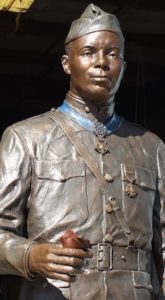
Freddie Stowers (statue)
*Freddie Stowers was born on this date in 1896. He was a Black corporal in the United States Army.
Stowers was born in Sandy Springs, South Carolina, and was the grandson of slaves. As a young adult, he worked as a farmhand and married a woman named Pearl, with whom he had one daughter, Minnie Lee.
Stowers was drafted into the Army in 1917 and assigned to Company C, 1st Battalion of the segregated U.S. 371st Infantry Regiment, originally part of the 93d (Colored) Infantry Division. While the United States Army had established permanent Black military units in 1866, these did not participate in the American Expeditionary Force; a peacetime role as frontier police and cavalry experts was gradually devolving into labor duties, and the fate of many Black troops in the world wars, despite the protests of some officers and organizations like the NAACP. Some of these "Buffalo Soldiers," as they were nicknamed, did participate in a border skirmish with Mexican troops accompanied by German military advisors near Nogales.
By contrast, Stowers was part of a new division that included a commissioned African American officer and saw sustained combat by the war's end. Due to compromises with institutional racism, this combat did not take place under American command: although his unit had arrived in France as part of the American Expeditionary Force, Stowers' regiment, like the others in the division, was seconded to the 157th French Army "Red Hand Division," badly in need of reinforcement, under the command of the General Mariano Goybet. Freddie Stowers died on September 28, 1918.
Early that morning, his company was ordered to assault Côte 188, a tall, heavily defended hill overlooking a farm near Ardeuil-et-Montfauxelles in the Ardennes region of France. At first, the German defenders offered stiff resistance, bombarding the Americans with mortars, raking them with machine guns, and keeping up steady rifle fire. However, the advance was not halted, with the Americans steadily gaining ground, and the Germans communicated their surrender with verbal and hand signals. This, however, proved to be a trick, and as Company C drew near the German trenches, the machine guns opened up again. Within minutes, the company's strength was reduced by half. The lieutenant commanding Stowers' platoon went down, followed by the more senior noncommissioned officers.
Corporal Stowers, trained to lead a section of a rifle squad, was now in command of a battered and demoralized platoon. Stowers began crawling toward a German machine gun nest and shouted for his men to follow. The platoon reached the first German trench line and reduced the machine guns by spray fire. Stowers then reorganized his force and led a charge against the second German line of trenches. During this assault, Stowers was struck by an enemy machine gun but kept going until he was hit. He collapsed from loss of blood but ordered his men not to be discouraged and to keep going and take out the German guns. Inspired by Stowers' courage, the men forged ahead and successfully drove the Germans from the hill into the plain below. Stowers died from his wounds on Côte 188.
He is buried, along with 133 of his comrades, at the Meuse-Argonne American Cemetery and Memorial east of the village of Romagne-sous-Montfaucon. Shortly after his death, Stowers was recommended for the Medal of Honor, a recommendation that was never processed. Three other Black soldiers were also recommended for the Medal of Honor but were awarded the next highest, Distinguished Service Cross.
This decision may have partly been motivated by racism; however, the criteria for the Medal of Honor were becoming stricter during this period, partly due to a perception that it was being awarded too frequently, especially to members of the Army, while members of the naval services could receive one of two different medals, both called the Medal of Honor. Marine officer Smedley Butler, for instance, might have received three or four, instead of two, total Medals of Honor, or he might have received only one if the actions for which they were awarded had occurred only a few years earlier or later than they did. Many possibly deserving whites and persons of color were denied medals, while some fewer deserving people received them.
In Stowers' case, the official position was that his recommendation was "misplaced." In 1990, at the instigation of Congress, the Department of the Army conducted a review, and the Stowers recommendation was uncovered. Subsequently, a team was dispatched to France to investigate the circumstances of Stowers' death. Based on information collected by this team, the Army Decorations Board approved the award of the Medal of Honor. On April 24, 1991, seventy-three years after he was killed in action, Stowers' surviving sisters, Georgina and Mary, received the medal from President George H.W. Bush at the White House.
In his article for the magazine Military History, LTC Taylor Voorhis Beattie compared Stowers to the more famous Sergeant Alvin York. Both were poor, semi-literate southern farm boys drafted into the Army and earned the Medal of Honor for their extraordinary and inspirational courage under fire on the Western Front. York, however, survived the war and returned home to national acclamation. At the same time, Stowers made the ultimate sacrifice for his country but remained an obscure figure who was not given his due until nearly a century after his death.
The outcome of the Stowers review led to a new Army study in 1992, which found that several blacks and other nonwhite DSC recipients from World War II deserved Medals of Honor that were not awarded because of bias on the part of the Decorations Board. President Bill Clinton upgraded their crosses to Medals of Honor and presented them to recipients or survivors.
Stowers Elementary School on Fort Benning, Georgia, and Corporal Freddie Stowers, Single Soldier Billeting Complex on Fort Jackson, South Carolina, are both named in his honor.